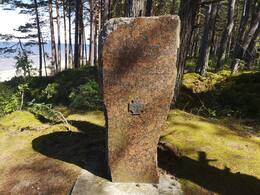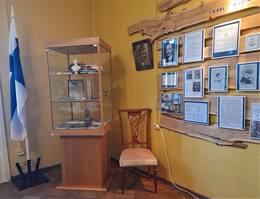About Finnish Jaegers in Latvia
The history of the Finnish Jaegers is interesting because it is extremely similar to the fate of Latvian soldiers in World War I and their great importance in the creation of a national state. For the Finns, World War I was also an opportunity to lay the foundations for Finnish independence and the creation of its army. The source describes the event when a monument to the Finnish Jaegers is unveiled in Latvia.
“On September 7 of this year, in Klapkalnciems on the seashore, approximately 15 kilometers from Smārde station, 5 Finnish riflemen of the 27th Jaeger Battalion were laid to rest: FV Heinonen, Viktors Kami, Emīls Kantola, Eikars Minti and Konrāds Pērssons, who fought in the Great World War as volunteers and fell in 1916. The Finnish government wanted to erect a monument to these fighters and thus honor those who hoped to win independence for their nation. Since the Latvian Defense Society had already erected a monument to the Finnish riflemen at the Galiņi house (in the vicinity of Olaine) in 1925, the Finnish Riflemen's Union, through the local Finnish embassy, asked the society to also erect a monument in Klapkalnciems, which the society gladly undertook, in order to promote good Finnish-Latvian relations. The granite components of the monument were brought from Finland and with great difficulty had to be delivered to the seaside of the village of Klapkalna, along the bad roads there. After weeks of work and considerable expenses, the monument was erected and its surroundings beautified. On the day of the consecration, (7 September), the following left for Klapkalna: the Finnish envoy to Latvia Hininen, the Chief of the Finnish General Staff, Colonel V allenius, who is also the chairman of the Finnish Riflemen's Union; the head of the information department, Lieutenant Colonel Relanders, the military representative, Colonel Helsingius; the Finnish sisters of mercy and the guards Munk and Rompanen; the deputy chief of staff of the commander of our army, Colonel Hartmanis, with the adjutant, Captain Kalniņš and members of the board of the Latvian Defence Society. On the way, there were problems with the cars, which broke down due to the bad roads, could not cross broken bridges and overpasses. The drivers arrive at the place of celebration with 3 hours late. Residents of the area, gathered in large numbers. Our and Finnish flags flutter in high garlands at the four corners of the monument; the poles are decorated with garlands and flowers, which were made by the hardworking Klapkalnietes, despite the bad, rainy weather. The celebrations were opened by the Finnish envoy Hininen, in Finnish and German, explaining the meaning of the monument and sincerely thanking the board of the Latvian Defense Society for the efforts made in erecting the monument. The envoy envoy lays a magnificent wreath with the Finnish national ribbon. Then Colonel Valenius speaks and ends his speech in Latvian, saying the following significant words: “This monument, under which the Finnish jaegers are laid, should be a sign to the youth that they should be ready for a persistent fight for the freedom and independence of their land. Citizens of Latvia, you have liberated your land in bitter battles, so "Even as we Finns, so let the monument remind us of the value and precious purchase of our freedoms. We will never give up our independence."
It is noteworthy that the Chief of the Finnish General Staff, Colonel Vallenius and Lieutenant Colonel Relander both fought in the ranks of the Jaegers and directly in this battle zone and therefore stayed and will remember their battles. The distant Finnish guests sincerely thanked the landlady of the local Saklauški house, Alvīna Guņa, and her husband for their diligent care of the graves and entrusted them with these duties in the future. The participants of the celebration returned to Riga via Tukums, because the road there is better.”
Newspaper "Aizzargs". Unveiling of monuments to fallen Finnish riflemen in Klapkalns. 1929.
Related timeline
Related topics
Related objects
Monument in the memory of Finnish jaegers-sappers
Located in Engure municipality, on the side of the A10 highway near the Smārde tavern.
The memorial is located in the field opposite the Smårde pub, where the Battle of Smårde took place in 1916 during World War I. A Finnish Jaeger engineer company (~200 men) participated in the fighting as part of the German army. "Smårde Day" has become the official holiday of the military engineers of the Finnish army, which is still celebrated today.
The Finnish Jaegers were a unit of the German Army formed during World War I. They consisted mainly of nationally minded Finnish volunteers from the Russian Empire and Finland. The Battle of Smårde was one of the most significant offensive battles of the Finnish Jaegers, where new tactics were used at the time.
A month after this event, the Russian army attacked the German army near Smārde. Latvian combat units conducted reconnaissance of the Smārde area, built a supply road “Latvian Road” across the swamp, and participated in the fighting. About 300 Latvian fighters fell in the battles. Like the Finnish jaegers in the German army, the Latvian riflemen in the Russian army were the founders of their own national states and armies.
Latvian War Museum
The Latvian War Museum is located in the Old Town not far from the Freedom Monument in a historic defence building called the ‘Powder Tower’. There are 11 exhibits in the museum. There are various weapons, documents, uniforms, awards, badges and other items detailing the everyday life of a soldier in war. The Latvian War Museum is one of the oldest museums in Latvia. Its origins can be found in World War I. Museum’s collection was made up mainly of personal items of soldiers or items found on battlefields. After Latvia gained its independence the main goal of the museum became to create an exposition on the military history of Latvia and the active role of the population in protecting their land. In 1937 the museum was expanded and was technically one of the most modern museums in Europe at that time. The Powder Tower was one of the fortification towers of Riga. Some evidence dates back to 1330 where it has been mentioned as the ‘Sand Tower’. The tower was destroyed in 1621 when Riga was besieged by the Swedish Army. But in 1650 a new tower for storing gunpowder and weapons was built. After the city’s fortifications were taken down, the Powder Tower remains as one of the most important pieces of evidence of the Riga defence system.
Memorial plaque to the Finnish Jaegers in the Holy Trinity Cathedral in Liepāja
A memorial plaque dedicated to the Finnish Jaegers is located in Liepāja Holy Trinity Cathedral, Lielā iela 9.
The Finnish Jägers were a unit of the German Empire, formed by volunteers from Finland, which, under the name of the 27th Royal Prussian Jäger Battalion, took part in the First World War battles on the Eastern Front of Latvia in 1916-1917.
During World War I, the Grand Duchy of Finland was part of the Russian Empire and many Finns wanted a German victory in the war in order to promote the establishment of an independent state. On 20 November 1914, the Finnish Independence Movement was founded in Helsinki, which also planned to form the armed forces of an independent state. When the German government confirmed its readiness to train the Finns in January 1915, the recruitment of volunteers began and by the spring of 1916 almost 2,000 soldiers were stationed in Germany and were named the 27th Royal Prussian Jäger Battalion.
From June 1916 the battalion was on the Riga front, when it was moved to Liepaja until March 1917. After the February Revolution, the Russian Empire began to collapse and on 6 December 1917 the Finnish Parliament declared independence.
On 13 February 1918, the Battalion swore allegiance to Finland in the Holy Trinity Church in Liepāja. On 15 February 1918, the battalion left the port of Liepaja by ship to return home to the port of Vasa and take part in the Finnish Civil War against the Reds, who had staged a coup d'état on 27 January 1918. The well-trained and combat-experienced Jägers formed the core of the Finnish national army and a large number became commanders during the Second World War.
The battalion's flag, consecrated in Holy Trinity Church, became the first flag of independent Finland.
Apriki Museum Collections and Red Partisan Activity Areas
The Apriķi manor house houses the Apriķu Museum, whose exhibits tell about the ancient history of the region. The museum exhibits an exposition about the Finnish military figure Karl Gustav Mannerheim - 175 museum items, the interactive stand "KGMannerheim and Apriķi" (in three languages - Latvian, English and Finnish) with 6 sections - about the Apriķi manor, about KGMannerheim as a commander in the Winter War, as the freedom of Finland the leader of the battles and about his connection with the Aprikais.
The museum also displays World War II items with symbols of the German and Red Army, as well as a map - the areas of activity of the Red Partisans) and descriptions of the Red Partisans.
The Baroque ensemble of the Aprikku manor (Apprikken) building was formed by the Alokste River in the 18th century. at first. 20th century in the beginning, the owner of the manor is Carl Gustav Mannerheim, who later became the president of Finland, and is known as the author of the legendary Mannerheim line - the fortification system during the Winter War.










